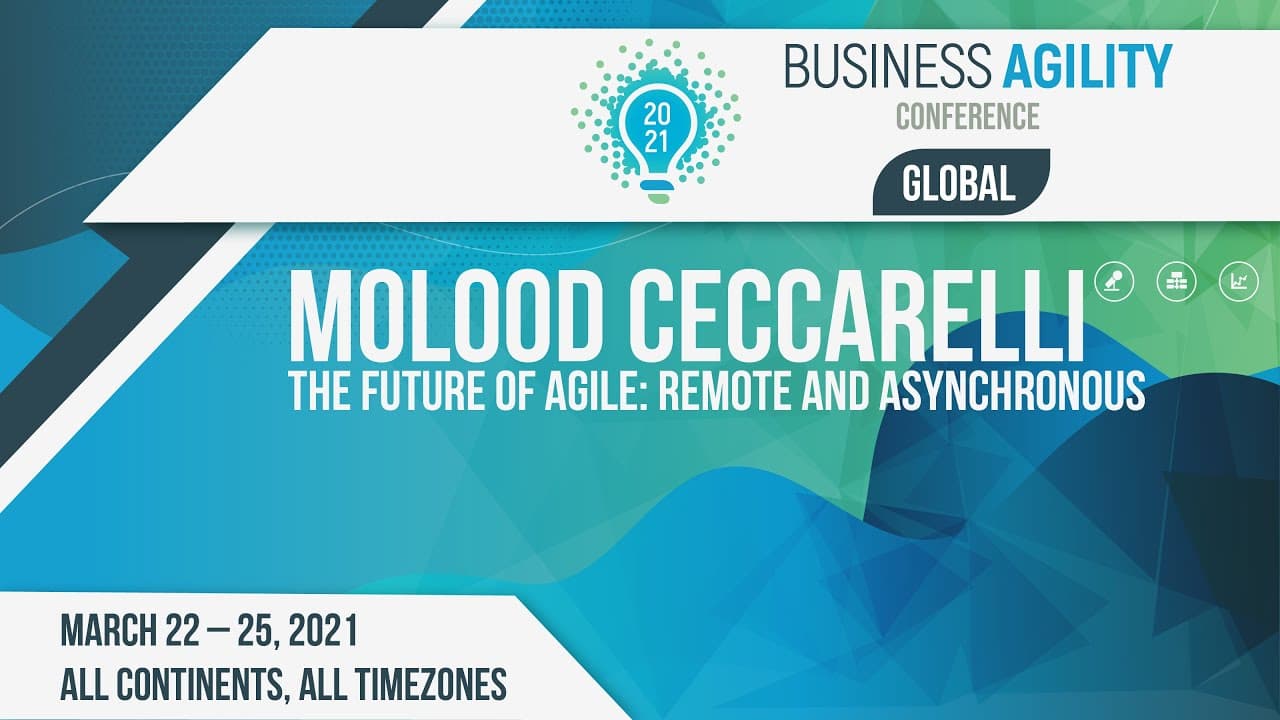Hello everybody! Today, we're going to be talking about the future of Agile, which, in my opinion, is remote—but not just the way you've been doing remote work since 2020. I believe the future of Agile is both remote and asynchronous.
Let’s dive deeper into what that really means. My name is Molood Ceccarelli, and as I was just introduced, I’m the founder and CEO of Remote Forever and the creator of the first online conference in the Agile world. Five years ago, I introduced the idea of remote work to Agile professionals, helping them understand that this is, indeed, the future. For five years, this has been my message, and today, it’s easier than ever for me to convey it. Thank you for being here and listening!
Where Do You Get Real Work Done?
I’d like to start with a question: Where do you go to get real work done? When you want to be productive, when you want to create results, when you need deep focus—where do you go?
Type your answer in the chat.
Personally, I used to love working from hotel lobbies, cafes with a view over a park, or near a body of water. Some responses I’m seeing in the chat: coffee shop, cafe, curled up on my couch. All valid options!
However, one answer I rarely hear is, "The office during the workday is where I get my best work done." In fact, a survey of 10,000 people in 2013 found that none of them said they go to the office when they need to be truly productive.
And yet, corporations continue to invest massive amounts of money in real estate. Even after the pandemic, only a few large companies have embraced fully remote work. Why? Because remote work is hard. Even after trying it, many companies still don’t know how to do it effectively.
Remote Work Acceptance is Growing
Gartner conducted a survey in April 2020, early in the pandemic, and found that 75% of CFOs planned to keep remote positions permanently. By July, as "Zoom fatigue" set in, another survey showed that 82% of company leaders wanted to allow remote work permanently. By December, that number had risen even higher.
The acceleration of remote work acceptance over the past year has been phenomenal.
Agile Adoption is Also Growing
According to the 2020 State of Agile Report, 97% of companies now have some form of Agile practice. When you put these trends together, it’s clear: Companies are becoming more distributed, and distributed companies are becoming Agile.
As I’ve been saying for years, remote work is not the future—it is the reality of work. I hope you have embraced it.
Working from Home vs. Working Remotely
Let me ask you another question: Do you work from home, or do you work remotely? And what’s the difference?
When we work from home during a pandemic, our freedom—the essence of remote work—is taken away. True remote work means having the freedom to work from wherever you feel most productive, just like you answered earlier.
Because many people experienced "remote work" under pandemic conditions, they may have a negative impression of it. But I challenge you to evaluate it objectively. How can we enable and empower people to work from anywhere, even if that place is an office?
The essence of remote work is freedom. My mission is to empower every knowledge worker to contribute meaningfully from anywhere they choose.
Work is Not a Place—It’s What We Do
I love this phrase, and I believe I first heard it from Jürgen Appelo: “Work is not a place. Work is what we do.”
Now, let’s examine the Agile Manifesto. I know you’ve all memorized it, but bear with me—this is important.
How Agile Companies Are Struggling with Remote Work
One of the most common questions I get from Agile teams new to remote work is: “What tool should I use for…?”
Fill in the blank: retrospectives, open space, conferences, standups. But Agile values individuals and interactions over processes and tools. If we rely too much on tools that add unnecessary complexity, we are not solving problems—we are creating them.
The Challenge of Meetings
We are drowning in meetings. Every day is filled with back-to-back calls. And yet, when things don’t work, we blame remote work instead of ineffective practices.
The Importance of Asynchronous Communication
Most organizations operate at a low level of remote maturity:
- Level 1: The company denies being remote (or has multiple offices but operates like a single-location company).
- Level 2: The company tries to replicate the office experience remotely (e.g., taking pictures of physical sticky notes and emailing them).
- Level 3: The company is distributed but entirely synchronous—meetings dominate the calendar.
- Level 4: The company prioritizes asynchronous communication.
- Level 5: “Nirvana” (very rare, but possible).
The Power of Asynchronous Work
Asynchronous communication means that information is shared when the sender is ready, and the recipient processes it when they are ready. It gives employees the freedom to work when they are most productive.
How can you enable this?
- Simplify. Agile values simplicity—the art of maximizing the work not done. I redefine this for remote work as maximizing the number of tools not used.
- Use task management systems as communication tools. Instead of chat and video calls, prioritize written documentation in tools like Jira, Trello, or Confluence.
Leadership Must Let Go of Command and Control
McKinsey research shows that leaders find remote work easier than their direct reports—because many still cling to command-and-control leadership. Employees feel micromanaged and constantly interrupted.
Try this: Introduce a new rule: No meeting is mandatory.
This forces teams to define the value of meetings, communicate purpose clearly, and engage participants. People will attend because they see value, not because they’re required to.
Final Thoughts
Transparency, simplicity, and asynchronous communication are the three pillars of effective remote work.
Remote work is not a challenge to overcome—it’s an opportunity to rethink work itself.
Thank you for your time!



